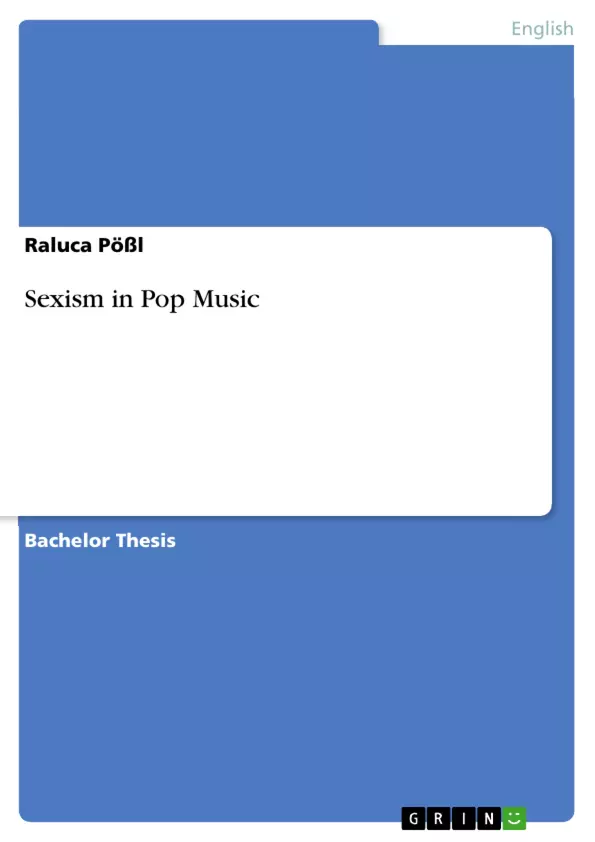This thesis has the purpose to attend to questions of the likes. Where are all the female musicians? Are there really so little of them or are they simply underrepresented? How are female musicians represented and portrayed if they are successful or trying to gain success? All of these questions above are heavily drenched with more or less visible sexism.
The first part of the thesis focuses on explaining how the current status quo has developed and what is keeping
it firmly in its place. The second part deals with the various existing forms of sexism, examining carefully the forms that are more difficult to recognize such as microaggressions and microinsults.
The final part looks closely at the female body and how it is used, portrayed and exploited, arguing that the female body is a social construction, shaped and used for clear purposes. Possible ways out are examined as well as the difficulty in seeking a transformation of representation since oftentimes solutions stem from the same source that created the
problems in the first place. The purpose of this thesis is neither to shame men nor condemn the industry altogether, although I will be critical and harsh of things that must be eyed critically. I attempt to shine a light on a new path that not only female artists have to take, but one that can and should be created hand in hand with record labels, managers and all people involved in the music business.
Inhaltsverzeichnis (Table of Contents)
- I. Introduction
- II.
- 1. The Power of Habit
- 2. Canon Wars
- 3. The Importance of Role Models
- III.
- 1. Forms of Sexism
- 2. Microaggressions
- 3. The Female Body
- IV. Conclusion
Zielsetzung und Themenschwerpunkte (Objectives and Key Themes)
This thesis aims to explore the issue of sexism in the pop music industry, addressing the underrepresentation of female musicians and analyzing how female artists are portrayed in a male-dominated environment. It examines the historical development of this imbalance and investigates the various forms of sexism that persist, including subtle forms like microaggressions and microinsults. Furthermore, it delves into the representation of the female body and its role in defining and limiting female musicians. The ultimate goal is to advocate for a more inclusive and diverse pop music landscape by highlighting the need for both artists and industry players to work together to eliminate existing inequalities and foster a more equitable future for female musicians.
- Underrepresentation of female musicians in pop music
- Forms of sexism and microaggressions in the industry
- The role of the female body in music and its portrayal
- Challenges and possibilities for change in the industry
- Importance of diversity and inclusion in the music landscape
Zusammenfassung der Kapitel (Chapter Summaries)
- I. Introduction: This chapter introduces the topic of sexism in pop music, drawing parallels between the situation of women in the music industry today and the historical context of the 1970s. It highlights the ongoing dominance of men in management, production, and songwriting, and emphasizes the need for change in a rapidly evolving music landscape. It uses the example of Alice Merton, a singer-songwriter who has successfully navigated the industry independently, as a case study for how female artists are taking control of their careers.
- II. 1. The Power of Habit: This chapter explores the historical development of the existing power dynamics in the music industry, highlighting the long-standing influence of male figures in shaping its structure and practices.
- II. 2. Canon Wars: This chapter examines the role of established narratives and traditional values in shaping the music industry's understanding of female artists. It delves into the concept of "canon wars" and how they influence the inclusion and representation of female musicians.
- II. 3. The Importance of Role Models: This chapter discusses the significance of having female role models in the industry, particularly in inspiring younger female artists and contributing to a more diverse and inclusive music landscape.
- III. 1. Forms of Sexism: This chapter investigates the different forms of sexism that are prevalent in pop music, including explicit and implicit forms of discrimination. It examines how sexism can manifest in subtle ways through microaggressions and microinsults.
- III. 2. Microaggressions: This chapter delves deeper into the topic of microaggressions, analyzing how subtle forms of prejudice and discrimination can have a significant impact on the experiences and career paths of female musicians.
- III. 3. The Female Body: This chapter focuses on the portrayal of the female body in pop music, exploring how it is used, exploited, and sometimes objectified. It examines the social construction of the female body and how it shapes the representation of female artists in the industry.
Schlüsselwörter (Keywords)
Key terms and concepts explored in this thesis include sexism, pop music industry, underrepresentation of female musicians, microaggressions, female body portrayal, diversity and inclusion, and the historical development of power dynamics in the music industry. The thesis also examines the role of female role models, the impact of social construction of the female body, and the potential for change in the industry.
- Citar trabajo
- Raluca Pößl (Autor), 2018, Sexism in Pop Music, Múnich, GRIN Verlag, https://www.grin.com/document/1170829



